#musicandsociety
Text
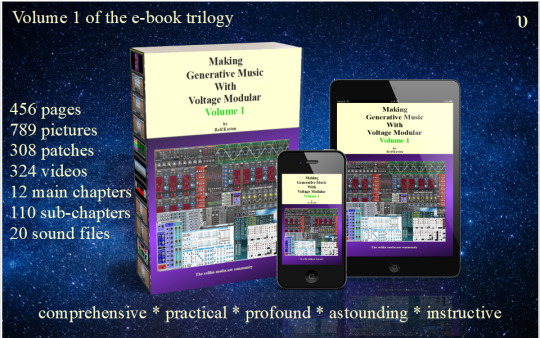
υ
What are the specific problems that I meet when producing generative patches? Get the answer here:
#GenerativeMusic#ModularSynths#MusicCreation#ElectronicMusic#Synthesizers#MusicProduction#Synths#CreativeProcess#MusicTechnology#MusicInnovation#MusicEducation#MusicInspiration#SynthEnthusiast#Composer#SynthPatches#SoundArt#ModularSoundscapes#MusicExploration#MusicLearning#learningmodular#VM#VoltageModular#Playertron#RM_Ware#Weevil#musicandsociety#musicandbiology#musicandphysics#cherryaudio#learningGenerativeMusic
0 notes
Photo










The Taitague family.
#TheTaitagueFamilyOwnersOfTheGoldCoast117911841148#GoldAndAmerica#TheGoldenYearsOfUsDemocracy#AmericaTheRich#EveryoneLovesTheTaitagueFamily#StoresOfGold#EasyTalkAndAmericanExcellence#GuamAndTheUnitedStates#TheNaplesCoastGuam#NaplesCoastGuamAndTheTaitagueFamily#MusicAndSociety
48 notes
·
View notes
Photo

Special shout out to @wescovey who is the teacher of the Music & Society class at Hebron Academy in Hebron, Maine. I am filled with joy after receiving this heart felt message he sent me about Dialogue: "As we wrapped up our discussions about the musical and social history of the United States, your record fit perfectly. It also helped me greatly both with providing a current perspective on many of the issues we have spoken about, and with helping me feel motivated and hopeful as I teach this class in today's difficult times. As I'm sure you know, it's easy to feel defeated these days, and your work gives me hope, as does working with these young people. The class is made up of kids from the US, China, Bermuda, Canada, Finland & South Korea. The dialogue is international!" Thank you Mr. Covey for using my album as part of your curriculum this school year. I'm honored that you chose it! Thank you to your students for being a part of the dialogue as well! #hebronacademy #hebron #hebronmaine #musicandsociety #dialoguealbum #dialogue #beapartofthedialogue #blackandwhitephotography (at Hebron, Maine)
#musicandsociety#dialoguealbum#hebronmaine#hebronacademy#beapartofthedialogue#dialogue#blackandwhitephotography#hebron
1 note
·
View note
Text
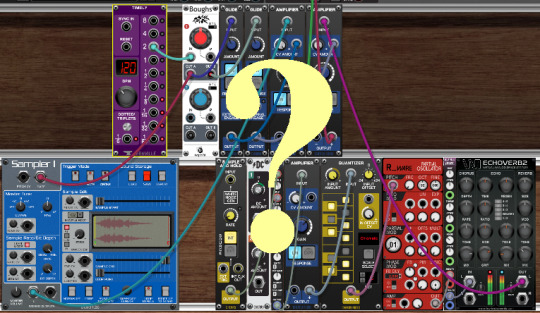
Every real understanding begins with asking the right questions. Here are mine (concerning generative music,):
α
Generative Music transfers some of the responsibility for a musical composition to a “machine” (a system). How? How much? Which ones? Why?
β
What role does chance play in generative music, and are there different types of chance, and if so, how do I generate them with modular synthesizers?
γ
What are the ingredients for generative music, and how do the “kitchen tools” work, the tools I process these ingredients with?
δ
Why are modular synthesizer systems so useful for producing generative music, and how do I get the most out of them?
ε
Does generative music always have to be ambient music? Or slow music? Or comfortable? Or dulcet?
ζ
Do I really need special modules that are suitable for making generative music?
η
What is so special about Voltage Modular that it deserves a whole e-book trilogy only about making generative music with this modular system?
θ
Why is it that generative music helps us understanding Albert Einstein?
ι
How many modules do I need to make generative Music with modular synths?
κ
Does a generative patch always have to run unattendedly?
λ
Can generative music be more or less generative? Is there a kind of degree?
μ
Do “real world” goings on play a role in generative music? Which one?
ν
Is generative music the most or the least human form of music?
ξ
Isn´t every modular synthesizer system potentially or even mainly a machine for creating generative music?
ο
Is generative music a genre, a style, a marketing term or simply a method of producing music?
π
How to prevent John from falling asleep when he is listening to generative music?
ρ
What do I really need to know when I want to make generative music with modular synths?
ς
Why is Voltage Modular one of the best modular synth systems when it comes to making generative music?
σ
Is there such a thing like “pseudo generative music”, and what and how could it possibly be?
τ
Does the term “composing generative music” make any sense?
υ
What are the specific problems that I meet when producing generative patches?
φ
Is producing generative music an alternative to learning music theory?
χ
Is it possible to produce generative dance music (EDM)?
ψ
What are the advantages that Voltage Modular has over other modular synth systems, and are there also disadvantages (which ones)?
ω
Is there an especially close relationship between generative music and modular synths?
ϊ
Where is my own creativity (is there any at all?) when I “provoke” a modular synth to make generative music?
ϋ
Is generative music of any commercial use (or is the invention of the term “generative music” a merely commercial act itself)?
ό
Does it make any sense to perform generative music live (and how may that possibly be done in an interesting way)?
ύ
Is generative music nothing else than musical pseudo-dadaismus?
ώ
What do have generative music and minimal music in common (if there is anything common at all)?
Read the whole article on https://www.dev.rofilm-media.net/node/622
Cheers and peace!
Enjoy your day!
Rolf
#GenerativeMusic#ModularSynths#MusicCreation#ElectronicMusic#Synthesizers#MusicProduction#Synths#CreativeProcess#MusicTechnology#MusicInnovation#MusicEducation#MusicInspiration#SynthEnthusiast#Composer#SynthPatches#SoundArt#ModularSoundscapes#MusicExploration#MusicLearning#learningmodular#VM#VoltageModular#Playertron#RM_Ware#Weevil#musicandsociety#musicandbiology#musicandphysics#cherryaudio#learningGenerativeMusic
0 notes
Text
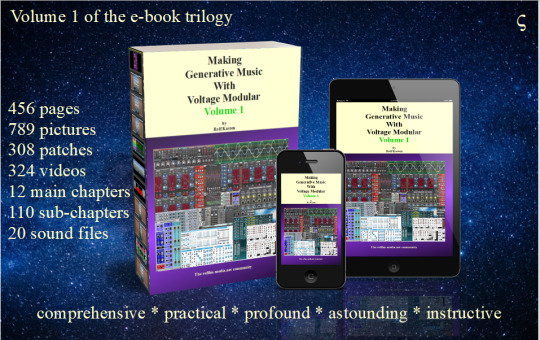
ς
Why is Voltage Modular one of the best modular synth systems when it comes to making generative music?
#GenerativeMusic#ModularSynths#MusicCreation#ElectronicMusic#Synthesizers#MusicProduction#Synths#CreativeProcess#MusicTechnology#MusicInnovation#MusicEducation#MusicInspiration#SynthEnthusiast#Composer#SynthPatches#SoundArt#ModularSoundscapes#MusicExploration#MusicLearning#learningmodular#VM#VoltageModular#Playertron#RM_Ware#Weevil#musicandsociety#musicandbiology#musicandphysics#cherryaudio#learningGenerativeMusic
0 notes
Text
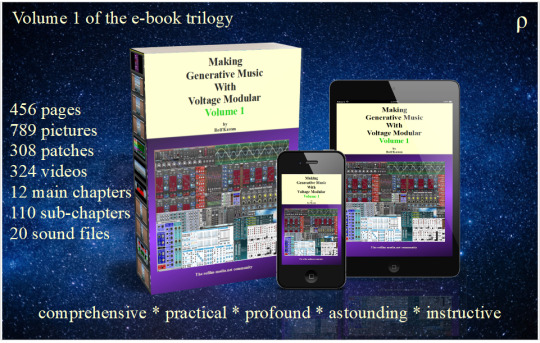
ρ
What do I really need to know when I want to make generative music with modular synths?
#GenerativeMusic#ModularSynths#MusicCreation#ElectronicMusic#Synthesizers#MusicProduction#Synths#CreativeProcess#MusicTechnology#MusicInnovation#MusicEducation#MusicInspiration#SynthEnthusiast#Composer#SynthPatches#SoundArt#ModularSoundscapes#MusicExploration#MusicLearning#learningmodular#VM#VoltageModular#Playertron#RM_Ware#Weevil#musicandsociety#musicandbiology#musicandphysics#cherryaudio#learningGenerativeMusic
0 notes
Text
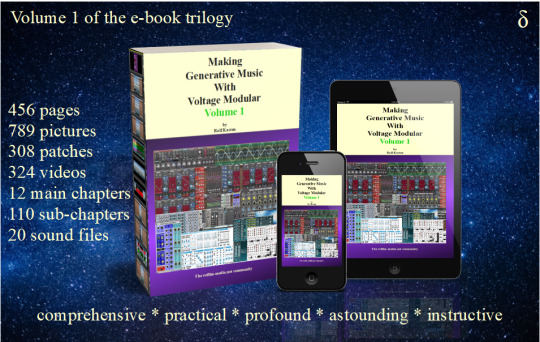
δ
Why are modular synthesizer systems so useful for producing generative music, and how do I get the most out of them?
#GenerativeMusic#ModularSynths#MusicCreation#ElectronicMusic#Synthesizers#MusicProduction#Synths#CreativeProcess#MusicTechnology#MusicInnovation#MusicEducation#MusicInspiration#SynthEnthusiast#Composer#SynthPatches#SoundArt#ModularSoundscapes#MusicExploration#MusicLearning#learningmodular#VM#VoltageModular#Playertron#RM_Ware#Weevil#musicandsociety#musicandbiology#musicandphysics#cherryaudio#learningGenerativeMusic
0 notes
Text

ν
Is generative music the most or the least human form of music?
#GenerativeMusic#ModularSynths#MusicCreation#ElectronicMusic#Synthesizers#MusicProduction#Synths#CreativeProcess#MusicTechnology#MusicInnovation#MusicEducation#MusicInspiration#SynthEnthusiast#Composer#SynthPatches#SoundArt#ModularSoundscapes#MusicExploration#MusicLearning#learningmodular#VM#VoltageModular#Playertron#RM_Ware#Weevil#musicandsociety#musicandbiology#musicandphysics#cherryaudio#learningGenerativeMusic
0 notes
Text
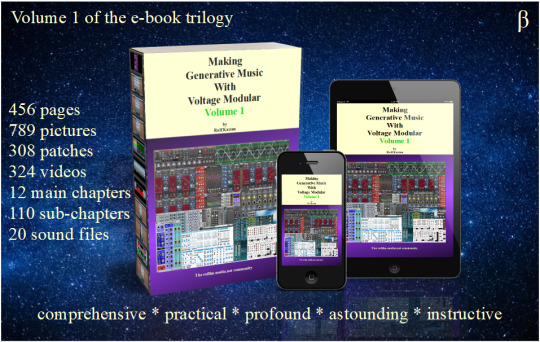
β
What role does chance play in generative music, and are there different types of chance, and if so, how do I generate them with modular synthesizers?
#GenerativeMusic#ModularSynths#MusicCreation#ElectronicMusic#Synthesizers#MusicProduction#Synths#CreativeProcess#MusicTechnology#MusicInnovation#MusicEducation#MusicInspiration#SynthEnthusiast#Composer#SynthPatches#SoundArt#ModularSoundscapes#MusicExploration#MusicLearning#learningmodular#VM#VoltageModular#Playertron#RM_Ware#Weevil#musicandsociety#musicandbiology#musicandphysics#cherryaudio#learningGenerativeMusic
1 note
·
View note
Text
α
Generative Music transfers some of the responsibility for a musical composition to a “machine” (a system). How? How much? Which ones? Why?
#GenerativeMusic#ModularSynths#MusicCreation#ElectronicMusic#Synthesizers#MusicProduction#Synths#CreativeProcess#MusicTechnology#MusicInnovation#MusicEducation#MusicInspiration#SynthEnthusiast#Composer#SynthPatches#SoundArt#ModularSoundscapes#MusicExploration#MusicLearning#learningmodular#VM#VoltageModular#Playertron#RM_Ware#Weevil#musicandsociety#musicandbiology#musicandphysics#cherryaudio#learningGenerativeMusic
0 notes
Text
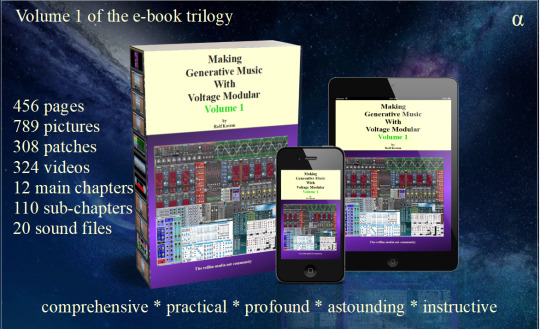
It´s done! The book is available on
(you can even read the first chapter of the book there).
Without a lot of words about “how great” or “how important” this book is, here´s what it contents. Decide yourself!
Cheers and peace!
Rolf
Chapter 0: Some Words About Generative Music And About This Book 006
Chapter 1: Pseudo Randomness And Its Advantages and Disadvantages 008
Chapter 1.1: Using LFOs To Generate Pseudo Randomness 009
Chapter 1.2: Special LFOs And Other Cycle Generating Modules 028
Chapter 1.2.1: R_ware´s “LFO-inator” 028
Chapter 1.2.2: R_ware´s “SplineCurve” 034
Chapter 1.2.3: Looping Envelopes 041
Chapter 1.2.3.1: Mini Envelope VCA Plus by Andrew Macaulay 041
Chapter 1.2.3.2: Super Envelope Generator (Cherry Audio) 050
Chapter 1.2.3.3: AHR Generator (Adroit) 058
Chapter 1.2.3.4: Playertron´s Membrane Function Generator 065
Chapter 1.2.3.5: Benard´s Stochastic SR Envelope 075
Chapter 1.2.3.6: Voltage Modular And the Music Of the Krell 079
Chapter 1.2.3.6.1: Step 1 - Patching a Krell Engine 080
Chapter 1.2.3.6.2: Step 2 – Adding Breakpoints And Modulations 083
Chapter 1.2.3.6.3: Step 3 – The Role Of Sequencers In Krell Patches 091
Chapter 1.2.3.6.4: Step 4 – A Cascade of Krell Engines 093
Chapter 1.2.3.6.5: Step 5 – Modulating Minima And Maxima 095
Chapter 1.2.3.6.6: Step 6 – Polyphonic Krell 099
Chapter 1.2.4: Sequencers 102
Chapter 1.2.4.1: Stochastic CV Sequencers 108
Chapter 1.2.4.1a: Playertron´s Stochastic Note & CV Sequencer 114
Chapter 1.2.4.2: Stochastic Trigger Sequencers 121
Chapter 1.2.5: Shift Registers 125
Chapter 1.2.5.1: DMT´s Shift Register 131
Chapter 1.2.5.1.a: Parrot Machine 132
Chapter 1.2.5.2: Micro Feedback Shift Register
(Synthetic Future x R_Ware) 134
Chapter 1.2.6: Sequential Switches 138
Chapter 1.2.6.1: CHASER by Borkman 146
Chapter 1.2.7: Gray Code Modules 150
Chapter 1.2.8: Samples And Recordings 156
Chapter 1.2.9: Euclidean Sequencers 159
INTERLUDE 1: Randomness, Probability, Stochastic 164
Chapter 2: Different Kinds Of “Real” Randomness 169
Chapter 2.1: Sample & Hold Modules 169
Chapter 2.1.a: Andrew Macaulay´s “Sample/Track And Hold” 172
Chapter 2.1.b: Micro¨Sample And Hold (Synthetic Future x R_Ware) 174
Chapter 2.1.1: Sample Sources for Sample & Hold Modules 175
Chapter 2.1.1.1: Sampling From Regular Wave Shapes 176
Chapter 2.1.1.2: Sampling from Audio 179
Chapter 2.1.1.3: Sampling from Anything 182
Chapter 2.2: Turing Machines 184
Chapter 2.2.1: DMT´s “Turing Universe” 185
Chapter 2.2.2: Playertron´s Turing Algorithm Tape Splicer 191
INTERLUDE 2: Gates And Switches 203
Chapter 2.3: Probability Gates And Random Gates 210
Chapter 2.3.1: HetrickCV´s “Random Gates” 210
Chapter 2.3.2: “Stochastic Trigger Distributor” (Playertron) 212
Chapter 2.3.3: “scrambler” (sys.6 / planet.6) 213
Chapter 2.3.4: “Pulse Train” (Centripidity) 215
Chapter 2.3.5: Bernoulli Gates 227
Chapter 2.3.6: Probability Router 125 (Insomniac Music) 238
Chapter 2.3.7: Real World Triggers And Gates 230
Chapter 2.3.7.1: Triggers And Gates From Field Recordings 230
Chapter 2.3.7.2: Triggers And Gates From Observations 233
Chapter 2.3.7.3: “The Rhythm Of a Day” 234
INTERLUDE 3: Nature´s Paradigm 236
Chapter 3: Modulation Targets And Trigger Targets 248
Chapter 3.1: Pitch 249
Chapter 3.2: Timbre 252
Chapter 3.3: Filters and Equalisers 260
Chapter 3.4: Wave Shapers And Wave Folders 263
Chapter 3.5: Additive Techniques (Partials And More) 271
Chapter 3.6: Voices 281
Chapter 3.7: Rhythm 284
Chapter 3.8: Effects 291
Chapter 3.9: Envelopes 295
Chapter 3.10: Quantizers 297
Chapter 3.11: Grains 299
Chapter 3.12: Sample Player 307
Chapter 3.13: Slew Processors / Limiters 311
Chapter 3.14: Comparators 313
Chapter 4: Compositional Aspects Of Generative Music 316
Chapter 4.1: Basic Compositional Decisions 316
Chapter 4.2: Basic Compositional Techniques 327
Chapter 4.2.1: Contrasting 327
Chapter 4.2.2: Repeating, Modifying And Inverting Relations 330
Chapter 4.2.3: Basic But Exclusively Generative Techniques 335
Chapter 4.3: Specific Compositional Techniques 339
Chapter 4.3.1: Pitch Dependency 339
Chapter 4.3.2: Rhythm 340
Chapter 4.3.3: Tension And Layers 345
Chapter 4.4: Certain Patch Techniques And Examples 347
Chapter 4.4.1: Switching Voices And Layer Parts Of the Patch 347
Chapter 4.4.2: Sculpture Randomness And Setting Borders 353
Chapter 4.4.3: Mixing Regular And Random Elements 356
Chapter 5: Building Blocks Of Generative Patching 363
Chapter 5.1: The Instrumentation Of Envelopes 363
Chapter 5.2: 5 Faces Of Randomness 370
Chapter 5.3: Random Harmonies 381
Chapter 5.3.1: Basic Random Arpeggio Set-Ups 381
Chapter 5.3.2: Certain Modules To Work With Harmonies 384
Chapter 6: Generative Principles In Nature And Society
And Their Musical Reproduction 391
Chapter 6.1: The Physicist´s Tunes 391
Chapter 6.1.1: Heisenberg´s General Pings 391
Chapter 6.1.2: Einstein´s Melody Of the Spheres 393
Chapter 6.1.3: de Broglie´s Electron Concert 393
Chapter 6.1.4: Heisenberg´s Cosmic Pings (plus a fun patch) 398
Chapter 6.1.5: Feynman´s Dance Of the Quarks 403
Chapter 6.2: The Biologist´s Tunes 407
Chapter 6.2.1: The Symphony Of Photosynthesis 407
Chapter 6.2.2: Enzymatic Choirs 410
Chapter 6.3: Society´s Tunes 414
Chapter 6.3.1: The Wailing Shopping Mall 414
Chapter 6.3.2: City Death Tune 417
Chapter 7: Modules Which Are Especially Useful
When Making Generative Music 421
Chapter 7.1: Quadrature VLFO by Cyberwerks Heavy Industries 421
Chapter 7.1.1: Functionality 421
Chapter 7.1.2: Applications 424
Chapter 7.2: “Feigen” by Vult 428
Chapter 7.2.1: Functionality 428
Chapter 7.2.2: Applications 430
Chapter 7.3: “Distributor” by Vulpus Labs 433
Chapter 7.3.1: Functionality 433
Chapter 7.3.2: Applications 434
Chapter 7.4: Jadwiga Single Pole Filter (Playertron) 437
Chapter 7.4.1: Functionality 437
Chapter 7.4.2: Applications 443
Chapter 8: The Bridge to Volume 2:
Certain Patch Ideas And Their Musical Meaning 447
Chapter 8.1: Competing Melodies And the Turn Of the Tide 447
Chapter 8.2: Stream Of Life 449
Chapter 8.3: Immanent Threat 451
Epilogue 453
Appendix A: Your Personal Advantages As a Buyer Of this Book 454
Appendix B: Contact And Social Media 455
Appendix C: Copyright 456
#GenerativeMusic#ModularSynths#MusicCreation#ElectronicMusic#Synthesizers#MusicProduction#Synths#CreativeProcess#MusicTechnology#MusicInnovation#MusicEducation#MusicInspiration#SynthEnthusiast#Composer#SynthPatches#SoundArt#ModularSoundscapes#MusicExploration#MusicLearning#learningmodular#VM#VoltageModular#Playertron#RM_Ware#Weevil#musicandsociety#musicandbiology#musicandphysics#cherryaudio#learningGenerativeMusic
0 notes